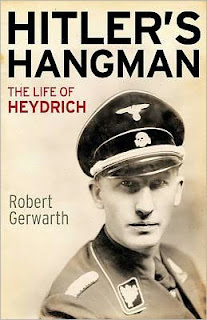I finally got around to watching the last part of the German mini-series "Unsere Mütter, unsere Väter" last night. It first aired in Germany earlier this year, and caused something of a sensation, drawing enormous audiences, provoking spirited debate and anguished reflection and generally jumping the normal bounds inhabited by a TV programme.
 Meaning literally "Our Mothers, our Fathers", it is the story of 5 friends (3 men & 2 women) who meet up just prior to the invasion of the USSR in the spring of 1941 to swear eternal friendship and promise to meet again the following Christmas. They are perhaps a microcosm of the ordinary German population: 2 soldiers (one keen, one not), an ambitious singer, a nurse eager to do her duty for the Fatherland, and a Jewish tailor. None of them, tellingly, is a Nazi.
Meaning literally "Our Mothers, our Fathers", it is the story of 5 friends (3 men & 2 women) who meet up just prior to the invasion of the USSR in the spring of 1941 to swear eternal friendship and promise to meet again the following Christmas. They are perhaps a microcosm of the ordinary German population: 2 soldiers (one keen, one not), an ambitious singer, a nurse eager to do her duty for the Fatherland, and a Jewish tailor. None of them, tellingly, is a Nazi.What follows, over 3x90 minute programmes, shows what life - and the war - throws at the five friends, and crucially shows the ways in which they, like the vast majority of ordinary people, were subtly made complicit in both the Nazi regime and the all-pervading horrors of World War Two. The singer, Greta, for instance, has an affair with a Gestapo man, essentially to further her career; Wilhelm (the enthusiastic soldier) is disillusioned by his experience of the war, his less enthusiastic brother Friedhelm becomes totally apathetic and ruthless. I won't spoil your enjoyment by revealing too much more.
 |
| "We'll meet again, don't know where, don't know when..." |
Another positive was the film's production values, which were excellent. Acting throughout was never less than convincing, and - whisper it quietly - people got dirty..., army uniforms were never neatly pressed. I remember a veteran once saying to me that they could smell the Red Army before you could see them - this film gives a whiff of that grim olfactory realism. In this regard, the only complaint was that the deaths were far too neat - people shot once in the body rarely die instantaneously; yet here they did, irritatingly regularly.
There are other gripes... I found it rather unrealistic that the five friends kept bumping into each other. Considering the vast extent of German-occupied Europe between 1941-45, it was utterly implausible that the nurse and her soldier beau, for instance, should have bumped into each other - not once but twice! And that the Jew-cum-Partisan should recognise his childhood pal passing him in a Wehrmacht Kubelwagen... One is tempted to quip - "Of all the slit trenches in all the world..."
OK, I get it - the piece has to make a few concessions for the sake of a narrative structure. But there were other failings - the film also showed a rather peculiar "world view". It is probably to be expected that the Germans themselves would not be portrayed terribly sympathetically - they are all in some way seen as complicit (as the premise dictates), they are all 'collectively guilty' for the crimes of the Nazis.
Yet, beyond that, the film demonstrated some rather peculiar sympathies and prejudices. The Polish Underground Army (AK), for instance - in which the Jewish tailor finds temporary refuge - is portrayed as being rabidly and almost uniformly anti-Semitic. Now, anti-Semitism was not just a German disease, and there were certainly instances of it in wartime Poland. But, but... let us not forget that Poland has more individuals listed as "Righteous Among the Nations" - for saving Jews during the Holocaust - than ANY other country - and over 10 times the figure for Germany. So, to portray the Polish partisans as more anti-Semitic than any of the German characters on show was not only a gross distortion - it was grossly unfair.
More surprising, perhaps, was the positive spin that was put on the Red Army and the Soviet Union in the film. Not only did the benighted Polish partisans express the opinion that the Germans were worse than the Soviets, (they tended to view both as equally awful), but a would-be rape of the nurse character (Charlie) is interrupted by a stern (female) Red Army officer, who then finds her a position in a Red Army medical unit. If the scene were at all realistic, one fears, a captured German nurse like Charlie would have been raped - probably numerous times - before being unceremoniously shot.
One is tempted to wonder why the Soviet Union is portrayed in such a positive light - the only group incidentally that come out of the film with any apparent credit whatsoever. Indeed, such is the gloss applied, that - were it not for the excellent production values - one might have imagined that the film had been made during the dying days of the GDR!
Despite all this historically-themed griping - this is nonetheless an excellent film, which is well worth seeing (and it is due to be shown with subtitles as "Generation War" on BBC2 this winter). German TV's treatment of the Third Reich, the war, and the nation's complicity in both has clearly come a long way, but there is still - perhaps - a little way to go.
© Roger Moorhouse 2013
















